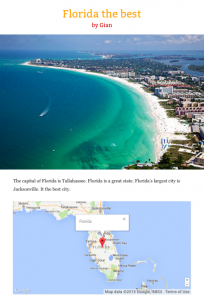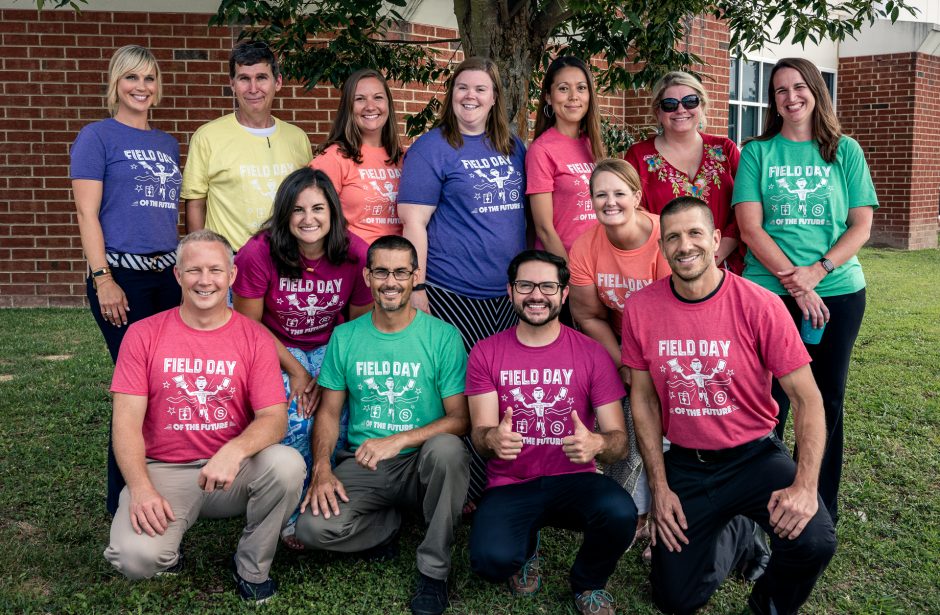 Fifth graders at Holladay Elementary have been learning about the states in the southeastern region of the United States (SE2.2b,c), so today students in Ms. Filer’s class created websites about a southeastern state of their choice. Since they had recently completed their benchmark tests, I was looking at the data, and I noticed that many fifth graders had a hard time identifying the point of view of the author and distinguishing between facts and opinions (SOL 5.5f, 5.6i). So I wanted to include those skills in my lesson as well. First we talked about point of view and how to identify the author’s point of view. Did the author have a positive or negative view of the topic they were writing about? Since our websites would be about a place, we looked at some online reviews for a local place, the Lewis Ginter Botanical Gardens. It was fairly easy to identify the author’s point of view by the words they used. Clearly some people enjoyed the gardens, while others did not. Next we practiced identifying facts and opinions in the reviews. I pointed out that usually a review could be considered more reliable if it included facts, instead of just opinions. We discussed where we should go to get the most reliable facts. Would the Botanical Gardens website be the most reliable, or could it be biased? I explained that the students would be creating a website about a southeastern state, and they would have to include facts and opinions, so it would be best if they had actually been to that state. I pointed out that the reader should be able to identify your point of view and tell whether you had positive or negative feelings about the state. The students could research their state using books or websites, and we used Tackk to create our websites. Tackk allows them to add text, maps, and photos of their state. After creating their websites, they posted the links on Google classroom with a question for their classmates to identify the facts, opinions, and viewpoint. Take a look at some samples here. This lesson was also submitted to Henrico21, so if you’d like to see the complete lesson plan, click here.
Fifth graders at Holladay Elementary have been learning about the states in the southeastern region of the United States (SE2.2b,c), so today students in Ms. Filer’s class created websites about a southeastern state of their choice. Since they had recently completed their benchmark tests, I was looking at the data, and I noticed that many fifth graders had a hard time identifying the point of view of the author and distinguishing between facts and opinions (SOL 5.5f, 5.6i). So I wanted to include those skills in my lesson as well. First we talked about point of view and how to identify the author’s point of view. Did the author have a positive or negative view of the topic they were writing about? Since our websites would be about a place, we looked at some online reviews for a local place, the Lewis Ginter Botanical Gardens. It was fairly easy to identify the author’s point of view by the words they used. Clearly some people enjoyed the gardens, while others did not. Next we practiced identifying facts and opinions in the reviews. I pointed out that usually a review could be considered more reliable if it included facts, instead of just opinions. We discussed where we should go to get the most reliable facts. Would the Botanical Gardens website be the most reliable, or could it be biased? I explained that the students would be creating a website about a southeastern state, and they would have to include facts and opinions, so it would be best if they had actually been to that state. I pointed out that the reader should be able to identify your point of view and tell whether you had positive or negative feelings about the state. The students could research their state using books or websites, and we used Tackk to create our websites. Tackk allows them to add text, maps, and photos of their state. After creating their websites, they posted the links on Google classroom with a question for their classmates to identify the facts, opinions, and viewpoint. Take a look at some samples here. This lesson was also submitted to Henrico21, so if you’d like to see the complete lesson plan, click here.


